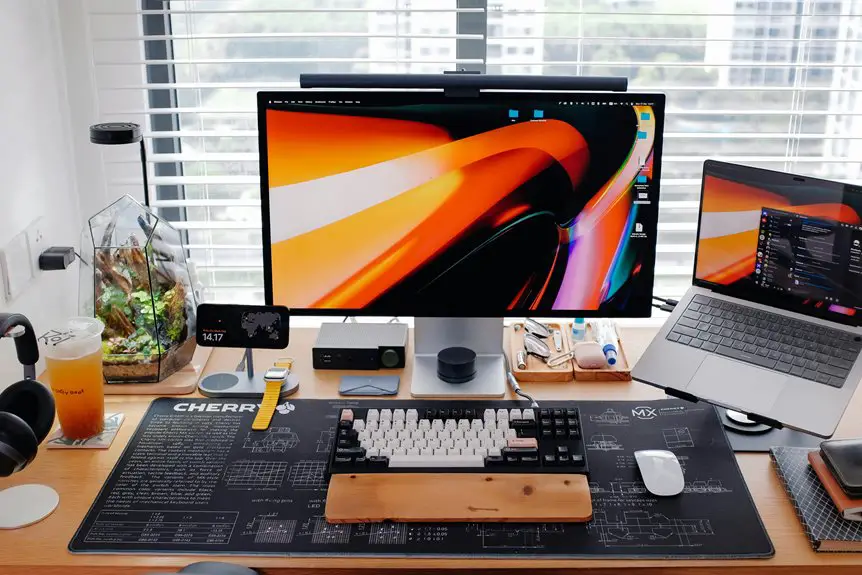When comparing mechanical and optical trackball mice, you'll find distinct pros and cons. Mechanical models offer precise navigation and tactile feedback but require more maintenance. On the other hand, optical options provide smooth tracking and ergonomic benefits with less wear and tear, though they may struggle on glossy surfaces. Your choice depends on your preferences and computing habits. Curious about which type fits best for your needs? Let's explore more details to help you decide.
Table of Contents
Key Takeaways
- Mechanical trackballs provide tactile feedback and durability, but require more maintenance to prevent dust buildup and ensure smooth operation.
- Optical trackballs offer enhanced precision and consistent performance with less wear, but are sensitive to environmental cleanliness and surface types.
- Mechanical models tend to be more expensive, while optical options are generally more budget-friendly, appealing to a wider range of users.
- Ergonomically, both types reduce wrist strain, but design preferences may vary based on individual comfort and usage needs.
- Customization options exist in both types, allowing users to tailor sensitivity and button functions for improved productivity.
Understanding Trackball Technology
When you explore trackball technology, you'll find it fundamentally different from traditional mice. Instead of moving the entire device, you'll rotate a large ball with your fingers or palm to control the cursor. This design allows for precise movements without needing to shift your hand around.
You'll notice that trackballs can save desk space since they don't require extensive movement like conventional mice. Moreover, the ergonomic benefits are significant, as your wrist stays in a more neutral position, reducing strain during extended use.
There are two main types: mechanical and optical, each utilizing different methods for tracking movement. Understanding these distinctions sets the stage for choosing the right trackball for your needs, enhancing your overall computing experience.
Advantages of Mechanical Trackball Mice
Mechanical trackball mice offer several advantages that can enhance your computing experience. Firstly, they provide precise control, allowing you to navigate effortlessly, especially in design or gaming applications.
You'll find that their stationary design saves desk space, which is great if you're working in a cluttered environment. Additionally, mechanical trackballs often have customizable buttons, enabling you to tailor functions to suit your workflow, boosting your productivity.
The durability of these devices is another plus; they can withstand heavy use without losing responsiveness. You'll also appreciate the tactile feedback they provide, making every movement feel intentional and satisfying.
Disadvantages of Mechanical Trackball Mice
While mechanical trackball mice offer some advantages, they come with their own set of drawbacks.
You'll find that they often require more maintenance due to dust and debris buildup, which can hinder performance.
Additionally, their limited precision control may not meet the demands of tasks that require fine accuracy.
Maintenance Requirements
Although mechanical trackball mice offer a unique ergonomic advantage, they come with significant maintenance requirements that can be a hassle for users.
You'll need to regularly clean the ball and the internal components to ensure smooth tracking. Dust and debris can easily accumulate, affecting performance.
Unlike optical mice, which are relatively low-maintenance, mechanical models require a bit more attention. You'll often find yourself disassembling the device to access the ball and clean the rollers, which can be time-consuming.
If you don't keep up with this maintenance, you might experience sticking or erratic behavior.
Ultimately, if you prefer a hassle-free experience, you might want to consider an optical trackball mouse instead.
Limited Precision Control
Maintaining a mechanical trackball mouse isn't the only drawback; precision control can also be an issue. You might find that the movement isn't as smooth or accurate compared to optical trackball mice. This can be frustrating, especially when you need to perform detailed tasks like graphic design or gaming.
| Aspect | Mechanical Trackball | Optical Trackball |
|---|---|---|
| Precision Control | Limited | High |
| Responsiveness | Slower | Faster |
| Surface Sensitivity | Dependent on cleanliness | Consistent |
| Ideal Use Cases | General tasks | Gaming, design |
Advantages of Optical Trackball Mice
When you switch to optical trackball mice, you'll notice enhanced precision control that makes navigating your screen feel effortless.
Plus, these devices significantly reduce finger strain, allowing you to work longer without discomfort.
Let's explore how these advantages can elevate your computing experience.
Enhanced Precision Control
Optical trackball mice offer enhanced precision control that can significantly improve your computing experience.
Unlike mechanical trackball mice, which rely on physical movement, optical technology provides smoother tracking and greater accuracy. You'll notice that even the slightest movement of your fingers translates into precise cursor control, making it easier to navigate intricate designs or small icons.
This level of precision is especially beneficial for graphic designers, gamers, or anyone who requires fine control for detailed tasks. Additionally, you won't have to deal with wear and tear on mechanical components, which can lead to erratic movements over time.
With consistent performance, optical trackball mice empower you to work or play with confidence and efficiency.
Reduced Finger Strain
Using an optical trackball mouse can significantly reduce finger strain, especially during long computing sessions. Unlike traditional mice, trackballs allow you to keep your hand stationary while moving the cursor with your fingers. This design minimizes repetitive movements and promotes a more natural posture.
Here are some specific advantages:
- Reduced Wrist Movement: Your wrist stays in a neutral position, lowering the risk of strain.
- Less Finger Fatigue: You can control the trackball with minimal effort, which helps prevent fatigue.
- Ergonomic Design: Many optical trackballs are designed to fit comfortably in your hand, enhancing support.
- Customizable Sensitivity: You can adjust settings to suit your comfort level, providing a tailored experience.
Choosing an optical trackball can make a noticeable difference in your comfort.
Disadvantages of Optical Trackball Mice
While many users appreciate the precision of optical trackball mice, they come with their own set of disadvantages. One major drawback is the need for a clean environment; dirt and dust can easily interfere with the sensor, leading to inconsistent tracking.
You might also find that optical trackballs require more frequent cleaning than mechanical ones, as debris can build up around the ball. Additionally, some users report that the sensitivity settings can feel overly finicky, making it challenging to achieve the right level of responsiveness.
If you're working on a glossy or reflective surface, you may experience tracking issues. Lastly, the initial cost of high-quality optical trackball mice can be higher, which mightn't suit everyone's budget.
Best Use Cases for Each Type
For different tasks, each type of trackball mouse has its own strengths that can enhance your experience. Knowing when to use mechanical or optical can make a big difference.
- Mechanical Trackball: Ideal for graphic design and CAD work, where precision and control are vital.
- Optical Trackball: Great for general office tasks and web browsing, offering smooth navigation on various surfaces.
- Mechanical Trackball: Suited for gaming, providing tactile feedback and quicker response times for competitive play.
- Optical Trackball: Best for casual users who want a low-maintenance option, as it doesn't require frequent cleaning.
Choosing the right trackball for your tasks can significantly improve your productivity and comfort during use.
Making the Right Choice for Your Needs
How do you decide between a mechanical and optical trackball mouse? Start by considering your primary usage. If you're into gaming or graphic design, an optical trackball offers precision and smooth movement.
On the other hand, if you prefer a tactile feel and durability, a mechanical trackball may be your best bet. Think about your workspace too. Optical mice typically work better on various surfaces, while mechanical models may require a specific setup.
If you travel often, an optical mouse's lightweight design might suit you better. Lastly, consider your budget; mechanical trackballs can be pricier.
Weigh these factors against your personal preferences to make the right choice that enhances your productivity and comfort.
Frequently Asked Questions
How Do I Clean a Trackball Mouse Effectively?
To clean your trackball mouse effectively, start by removing the ball. Wipe the ball and the housing with a damp cloth. Use a cotton swab for tight areas. Reassemble it and enjoy a smoother operation!
Can Trackball Mice Improve Wrist Ergonomics?
Yes, trackball mice can improve wrist ergonomics. They allow your hand to stay stationary while moving the cursor, reducing strain on your wrist. You'll likely experience less discomfort during extended use, making your work more comfortable.
Are Trackball Mice Suitable for Gaming?
Trackball mice can be suitable for gaming, but it depends on your preferences. They offer precision and comfort, allowing for quick movements. However, you might need some time to adjust to the different control style.
What Is the Lifespan of a Trackball Mouse?
A trackball mouse typically lasts between 3 to 5 years with regular use. Proper maintenance, like cleaning the ball and sensors, can extend its lifespan, ensuring you get the most out of your investment.
Do Trackball Mice Require Special Drivers or Software?
Trackball mice usually don't require special drivers or software; they often work with standard operating system settings. Just plug it in, and you're good to go. However, specific features may need additional software.




